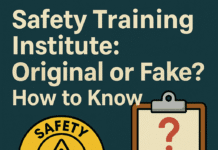
Associate Safety Professional: A Crucial Role in Ensuring Workplace Safety
Introduction
Workplace safety is a paramount concern for every organization, and the role of an Associate Safety Professional (ASP) plays a pivotal part in achieving this goal. ASPs are highly skilled and qualified individuals who are dedicated to creating a safe and secure working environment. In this article, we will delve into the responsibilities, qualifications, and the vital role that an Associate Safety Professional holds in various industries.
Understanding the Role of an Associate Safety Professional
An Associate Safety Professional is an expert responsible for developing, implementing, and managing safety programs within an organization. They work closely with management, employees, and other safety professionals to ensure that safety protocols are followed. Their primary objective is to prevent accidents, injuries, and potential hazards in the workplace.
The Importance of Safety Compliance
Safety compliance is a critical aspect of any organization. ASPs play a vital role in ensuring that all safety regulations, standards, and legal requirements are met. By adhering to these guidelines, companies not only protect their employees but also safeguard their reputation and avoid legal ramifications.
Qualifications and Certifications Required
To become an Associate Safety Professional, one must possess a solid educational background in safety management or related fields. Typically, a bachelor’s degree is the minimum requirement, along with relevant work experience. Additionally, acquiring certifications such as the ASP and CSP (Certified Safety Professional) from accredited organizations boosts credibility and enhances job prospects.
Implementing Effective Safety Programs
ASP’s are skilled in developing and implementing safety programs tailored to the specific needs of an organization. They assess potential risks, identify safety gaps, and create comprehensive strategies to address them effectively.
Conducting Risk Assessments and Hazard Analysis
Risk assessments and hazard analysis are integral parts of safety management. ASPs conduct thorough evaluations of workplace environments to identify potential hazards and assess risks. By understanding these risks, they can develop appropriate preventive measures and safety protocols.
Safety Training and Education
An essential responsibility of an ASP is to conduct safety training sessions for employees. These sessions ensure that all staff members are aware of safety protocols, emergency procedures, and the proper use of safety equipment.
Incident Investigation and Reporting
In the unfortunate event of an accident or incident, ASPs lead the investigation to determine its root cause. After gathering relevant data, they prepare detailed incident reports, enabling organizations to prevent similar occurrences in the future.
Emergency Preparedness and Response
ASP’s play a crucial role in developing emergency response plans. They ensure that employees are well-informed and trained to handle emergencies effectively, minimizing potential damage and ensuring everyone’s safety.
Ensuring Occupational Health and Wellness
Associate Safety Professionals prioritize the well-being of employees by promoting occupational health and wellness initiatives. These efforts contribute to a healthier and more productive workforce.
The Role of Technology in Safety Management
Advancements in technology have revolutionized safety management. ASPs leverage various tools and software to streamline safety processes, track incidents, and monitor compliance effectively.
Integrating Safety into Organizational Culture
To achieve long-term safety success, ASPs work to create a safety-oriented culture within the organization. They instill safety as a core value, ensuring that every employee actively participates in maintaining a secure work environment.
The Impact of an Associate Safety Professional on Productivity
Safety measures aren’t just about compliance; they significantly impact overall productivity. ASPs play a vital role in reducing absenteeism, improving employee morale, and minimizing downtime due to accidents or injuries.
Challenges and Solutions in Safety Management
Managing safety comes with its challenges, including resistance to change, budget constraints, and keeping up with evolving safety regulations. ASPs must proactively address these challenges and find innovative solutions to ensure ongoing safety improvement.
The Future of Safety Professionals
The role of Associate Safety Professionals will continue to evolve in response to the changing workplace landscape and technological advancements. Their expertise will remain critical in fostering safer working environments worldwide.
Conclusion
In conclusion, Associate Safety Professionals are essential assets for any organization committed to creating a safe and secure workplace. Their expertise, dedication, and skills significantly contribute to preventing accidents, protecting employees, and ensuring compliance with safety regulations. By prioritizing safety, organizations can boost productivity, reputation, and overall success.
FAQs
- Q: What is the primary responsibility of an Associate Safety Professional?A: An Associate Safety Professional is primarily responsible for developing, implementing, and managing safety programs within an organization.
- Q: What qualifications are required to become an ASP?A: To become an ASP, one must possess a bachelor’s degree in safety management or related fields, along with relevant work experience. Acquiring certifications such as the ASP and CSP further enhances credibility.
- Q: How do ASPs contribute to workplace productivity?A: ASPs contribute to workplace productivity by reducing absenteeism, improving employee morale, and minimizing downtime due to accidents or injuries.
- Q: What challenges do safety professionals face in their role?A: Safety professionals face challenges such as resistance to change, budget constraints, and staying updated with evolving safety regulations.
- Q: How will the role of Associate Safety Professionals evolve in the future?A: The role of Associate Safety Professionals will continue to evolve in response to changing workplace dynamics and technological advancements, maintaining their critical importance in ensuring workplace safety.
























